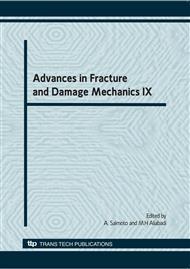p.93
p.97
p.101
p.105
p.109
p.113
p.117
p.121
p.125
The Effect on Dynamic Properties of Reactive Powder Concrete under High Temperature Burnt and its Micro-Structure Analysis
Abstract:
In this paper, the dynamic macroscopical properties of reactive powder concrete (RPC) are studied by using the split Hopkinson pressure bar (SHPB) system. The effect on dynamic properties of RPC material with different water binder ratio (W/B) and steel fiber influence under high temperature burnt is discussed. And scanning electron microscope (SEM) technology is also used to investigate the micro-structure change under high temperature burnt. The experiment result shows: without high temperature burnt, the higher water binder ratio, the lower dynamic compression strength of RPC material. With high temperature burnt, strength decreases exquisite. However, steel fiber can prevent micro-crack from generating, the toughness effect still alive after high temperature burnt. From SEM analysis: the inner part of RPC will have a series of physical chemistry changing, such as: micro-crack generation, C-S-H gel damage. This essential change is the basic reason for dynamic properties degrade.
Info:
Periodical:
Pages:
109-112
Citation:
Online since:
November 2010
Authors:
Price:
Сopyright:
© 2011 Trans Tech Publications Ltd. All Rights Reserved
Share:
Citation:


